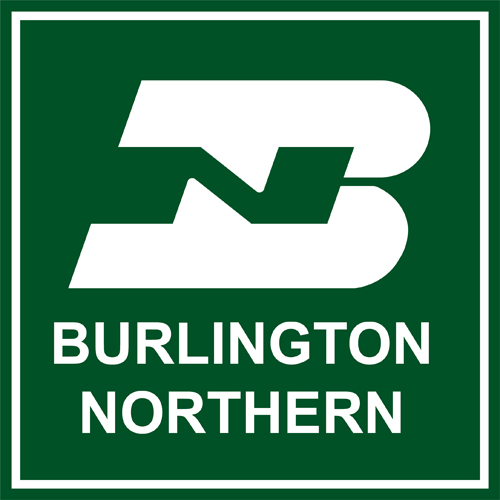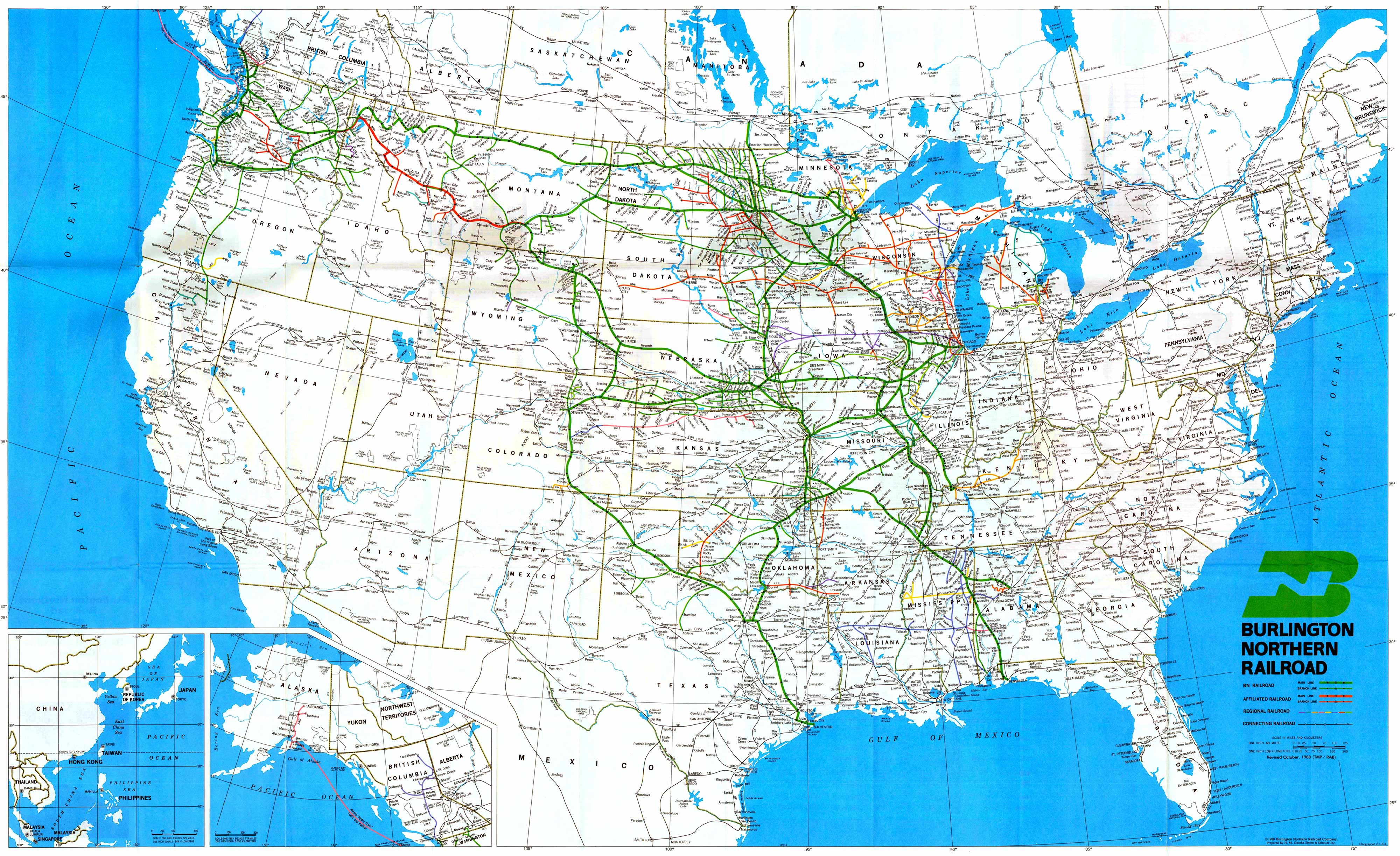Burlington Northern Railroad: Map, Logo, History
Last revised: August 23, 2024
By: Adam Burns
When created on March 2, 1970 the Burlington Northern was America's largest
railroad. With a network comprising a staggering 26,000 miles (excluding subsidiaries Colorado & Southern and Fort Worth & Denver) it even eclipsed the enormous Penn Central Transportation Company.
The history of what became BN included three previous attempts at merging the so-called "Hill Lines" (Chicago, Burlington & Quincy; Great Northern; Northern Pacific; and Spokane, Portland & Seattle).
It was the long-held dream of noted tycoon, James J. Hill, but alas his every attempt was denied on monopolistic grounds by the Interstate Commerce Commission. Several years after the Empire Builder's passing the great railroad was finally born. During its early years BN somewhat struggled due to stifling regulation and 1973's oil embargo.
However, with the passage of 1970's Clean Air Act, rise in cleaner burning Powder River Basin Coal, 1980's Stagger's Act, and the intermodal/container-on-flat-car (COFC) revolution the railroad's net revenues steadily rose.
With the mega-merger movement ongoing, and Union Pacific fast becoming the West's most dominant carrier, Burlington Northern and Atchison, Topeka & Santa Fe (Santa Fe) joined in 1995 to form the Burlington Northern & Santa Fe Railway. Today, it is known as BNSF Railway and ranks behind only UP as the country's most powerful railroad.
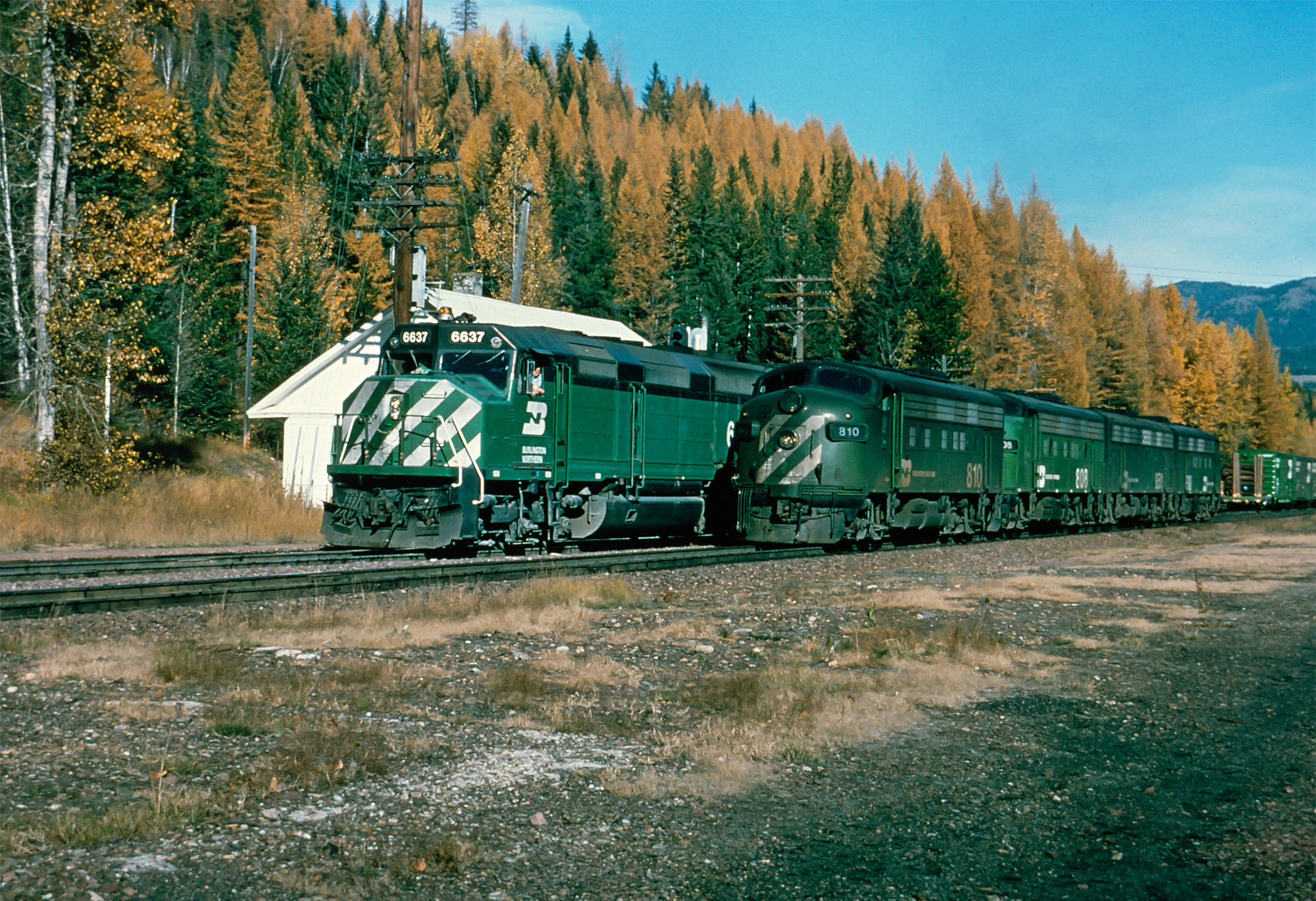 Burlington Northern F45 #6637 has an eastbound stopped at Essex, Montana circa 1976. Note the F9 helper set at right. American-Rails.com collection.
Burlington Northern F45 #6637 has an eastbound stopped at Essex, Montana circa 1976. Note the F9 helper set at right. American-Rails.com collection.History
The history of Burlington Northern began nearly 70 years before its creation. In 1893, James Hill completed his transcontinental Great Northern Railway (GN) between the Puget Sound and St. Paul/Minneapolis although he wasn't the first to do so.
Another, the Northern Pacific Railway (NP), had accomplished the very same feat five years earlier in 1888. In spite of this, Hill was a cunning and effective railroader who commanded the resources and shrewdness to dominate the Pacific Northwest. When NP entered receivership on August 15, 1893, following that year's financial panic, he gained a considerable stake in the property.
Logo
In 1901, the Empire Builder also grabbed the Chicago, Burlington & Quincy (CB&Q), which provided him with a direct route into Chicago. It was at this time that a fight broke out with another noted tycoon, Edward Harriman, who wanted control of the CB&Q. To do this, he acquired a considerable stake in Northern Pacific.
On May 3, 1901 Harriman established the "Northern Pacific Corner" and briefly accomplished his objective. Hill quickly countered by forming the Northern Securities Company which effectively placed GN, NP, and Burlington under common control.
This was the first attempt to merge the properties but proved short-lived. A Supreme Court order in 1904 broke up Northern Securities and it was forced to divest control of all three. However, by then, Harriman and had already sold his interest in NP.
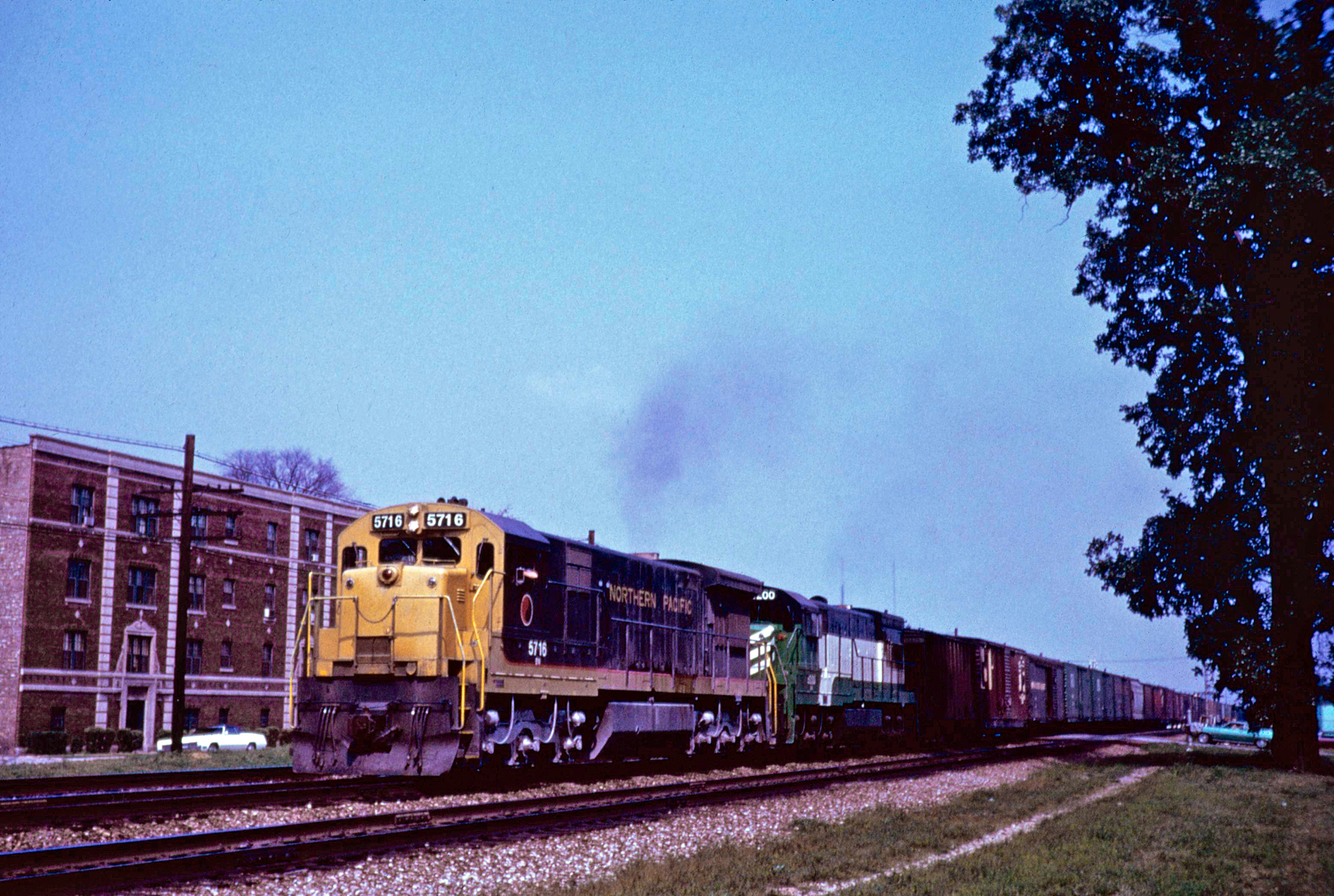 Burlington Northern U33C #5716 and U23C #5200 lead a general manifest west through Berwyn, Illinois on October 9, 1972. American-Rails.com collection.
Burlington Northern U33C #5716 and U23C #5200 lead a general manifest west through Berwyn, Illinois on October 9, 1972. American-Rails.com collection.According to the book "The Great Northern Railway, A History" by authors Ralph W. Hidy, Muriel E. Hidy, Roy V. Scott, and Don L. Hofsommer, he tried to reacquire his stock following the Supreme Court order but was denied in 1905.
After the Hill's death in 1917 another merger was attempted during the 1920's but was, again, blocked by the ICC. With little hope of seeing the union occur at that time the idea was dropped altogether. The proposal was not renewed until after World War II when many railroads contemplated merger to combat declining market share.
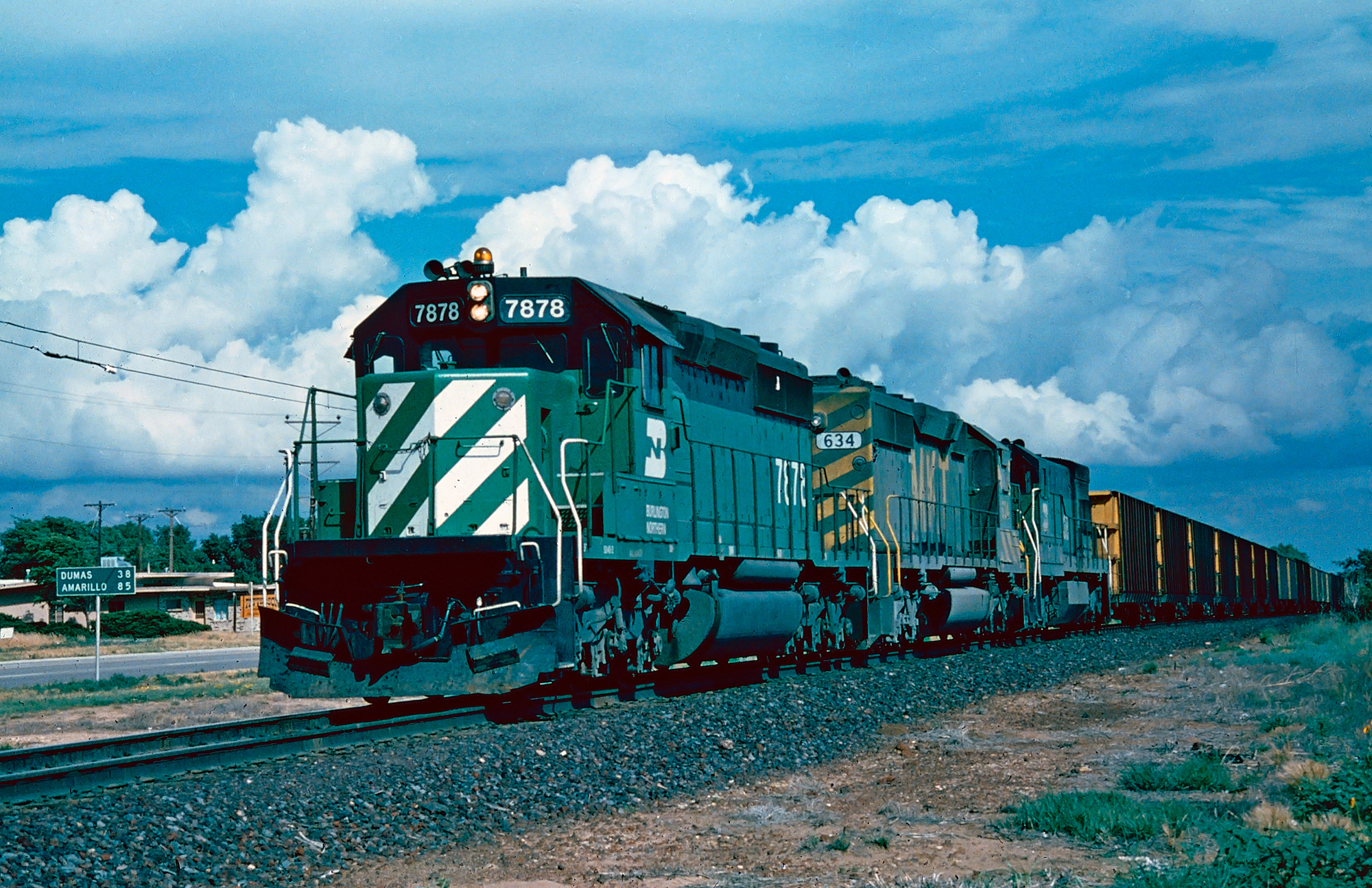 Burlington Northern SD40-2 #7878, Katy SD40-2 #634, and a BN GE, lead empties westbound through Dalhart, Texas, circa 1983. The BN/MKT had a joint agreement at this time where they pooled power to serve the Lower Colorado River Authority's coal-fired electric generating plant at Fayetteville, Texas, situated along the Katy. The train photographed here was returning to North Yard in Denver. Mike Bledsoe photo. American-Rails.com collection.
Burlington Northern SD40-2 #7878, Katy SD40-2 #634, and a BN GE, lead empties westbound through Dalhart, Texas, circa 1983. The BN/MKT had a joint agreement at this time where they pooled power to serve the Lower Colorado River Authority's coal-fired electric generating plant at Fayetteville, Texas, situated along the Katy. The train photographed here was returning to North Yard in Denver. Mike Bledsoe photo. American-Rails.com collection.While the industry remained heavily regulated the ICC realized its monopolistic nature had long since passed. As early as the 1920's the idea of creating three or four major eastern trunk lines was considered but later shelved when the stock market crashed in 1929.
The process that eventually created Burlington Northern began quietly in 1955 when the presidents of NP and GN launched informal discussions on the matter.
In his book, "Burlington Northern Railroad: Historical Review, 1970-1995," Robert C. Del Grosso notes this mega-railroad was originally to be called the Great Northern Pacific & Burlington Lines. It was believed the giant system could raise profits through capacity reductions and more fluid, point-to-point operations.
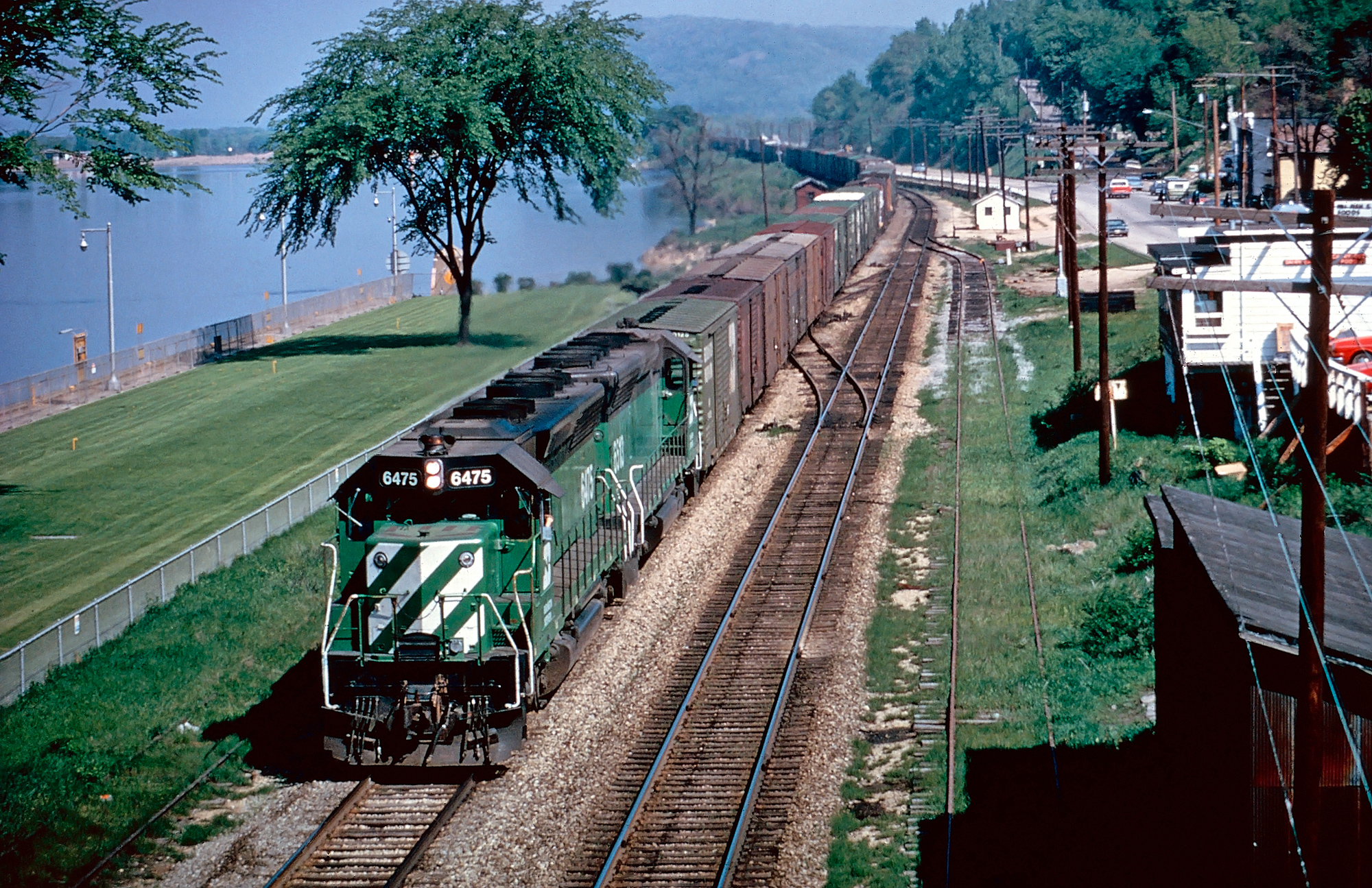 Burlington Northern SD45's lead a southbound/eastbound past Lock & Dam #4 along the Mississippi River at Alma, Wisconsin on May 19, 1973. David Kimmel photo. American-Rails.com collection.
Burlington Northern SD45's lead a southbound/eastbound past Lock & Dam #4 along the Mississippi River at Alma, Wisconsin on May 19, 1973. David Kimmel photo. American-Rails.com collection.Following the talks, a series of studies was conducted leading to a formal application filed with the Interstate Commerce Commission on February 17, 1961. The merger would officially bring together the Northern Pacific, Great Northern, and Chicago, Burlington & Quincy into the previously-named conglomerate.
It would comprise a network of 24,500 miles and lease the Spokane, Portland & Seattle for a period of 10 years before absorbing this property into the parent company. In typical ICC fashion the process moved forward very slowly. Finally, on March 31, 1966 the agency surprisingly voted against the merger in a 6-5 decision.
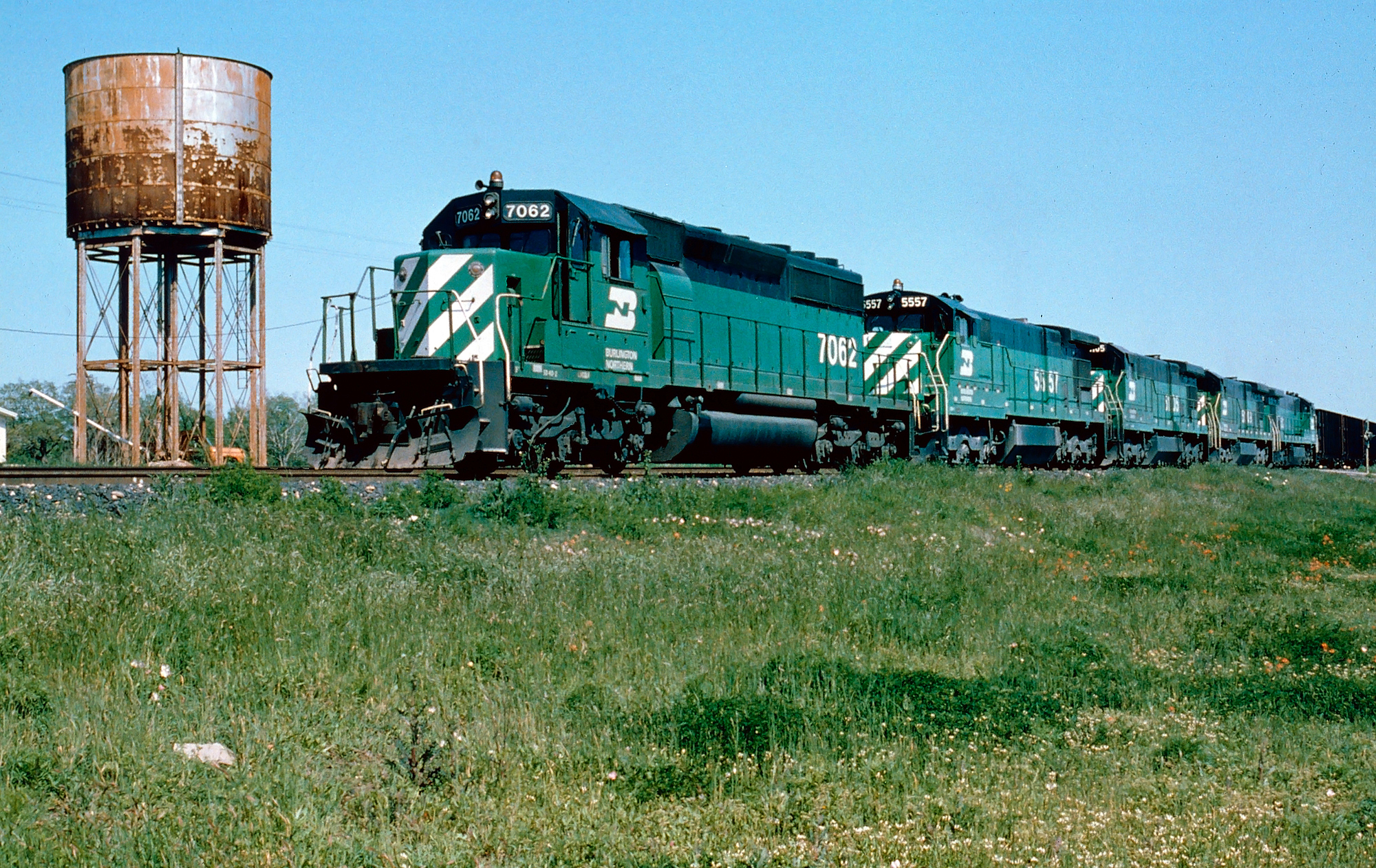 Burlington Northern SD40-2 #7062 and several GE's await a relief crew at Texline, Texas on the Fort Worth & Denver, circa 1984. Mike Bledsoe photo. American-Rails.com collection.
Burlington Northern SD40-2 #7062 and several GE's await a relief crew at Texline, Texas on the Fort Worth & Denver, circa 1984. Mike Bledsoe photo. American-Rails.com collection.Formation
Undeterred, the three railroads continued pressing for the union. A great hurdle was cleared when an agreement was reached with the Chicago, Milwaukee, St. Paul & Pacific (the "Milwaukee Road") stipulating that their only transcontinental competitor would be granted eleven new western gateways.
This strategic opportunity garnered the Milwaukee bountiful new sources of interchange business, particularly with the Southern Pacific at Portland, Oregon. With this issue resolved the ICC reopened hearings on January 4, 1967. Later that year, on November 30th, the merger was approved by an 8-2 vote.
As the process moved forward the new railroad's name was changed to Burlington Northern, Inc. (BNI) during April of 1968. After a bit more legal work and other objections were overcome the four systems became one at 12:01 AM on March 2, 1970.
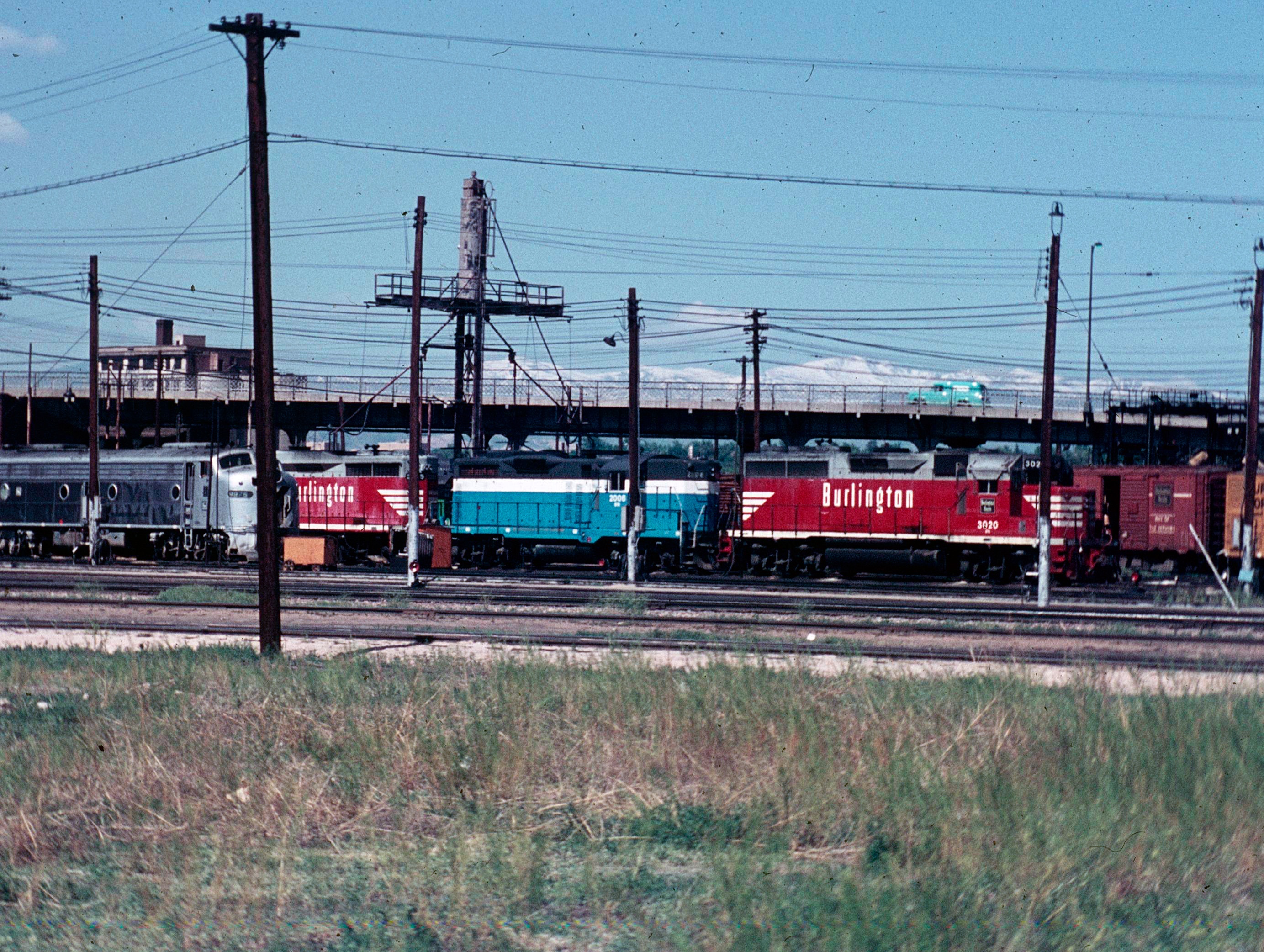 It's the early Burlington Northern era as predecessor power lays over in Denver, Colorado during July, 1971. Author's collection.
It's the early Burlington Northern era as predecessor power lays over in Denver, Colorado during July, 1971. Author's collection.25 Years Of Service
The new Burlington Northern dominated the West, dwarfing all other western carriers by several thousand miles.
Along with its four primary railroads, several smaller subsidiaries also comprised BN including:
- Pacific Coast Railroad (GN)
- Minneapolis, Anoka & Cuyuna Range Railroad (GN)
- Walla Walla Valley Railroad (An NP-owned interurban)
- Colorado & Southern (CB&Q)
- Fort Worth & Denver (CB&Q)
- Winona Bridge Railway (CB&Q)
- Oregon Electric Railway (An SP&S-owned interurban)
- Oregon Trunk Railway (SP&S)
- Lake Superior Terminal & Transfer (A joint GN/NP property)
- Midland Railway Company (A joint GN/NP property)
BN's total mileage was never larger than the year it was formed. At that time it possessed a network of 25,879 miles although this excluded the Colorado & Southern and Fort Worth & Denver. As the years passed it greatly reduced superfluous capacity, particularly following passage of 1980's Staggers Act.
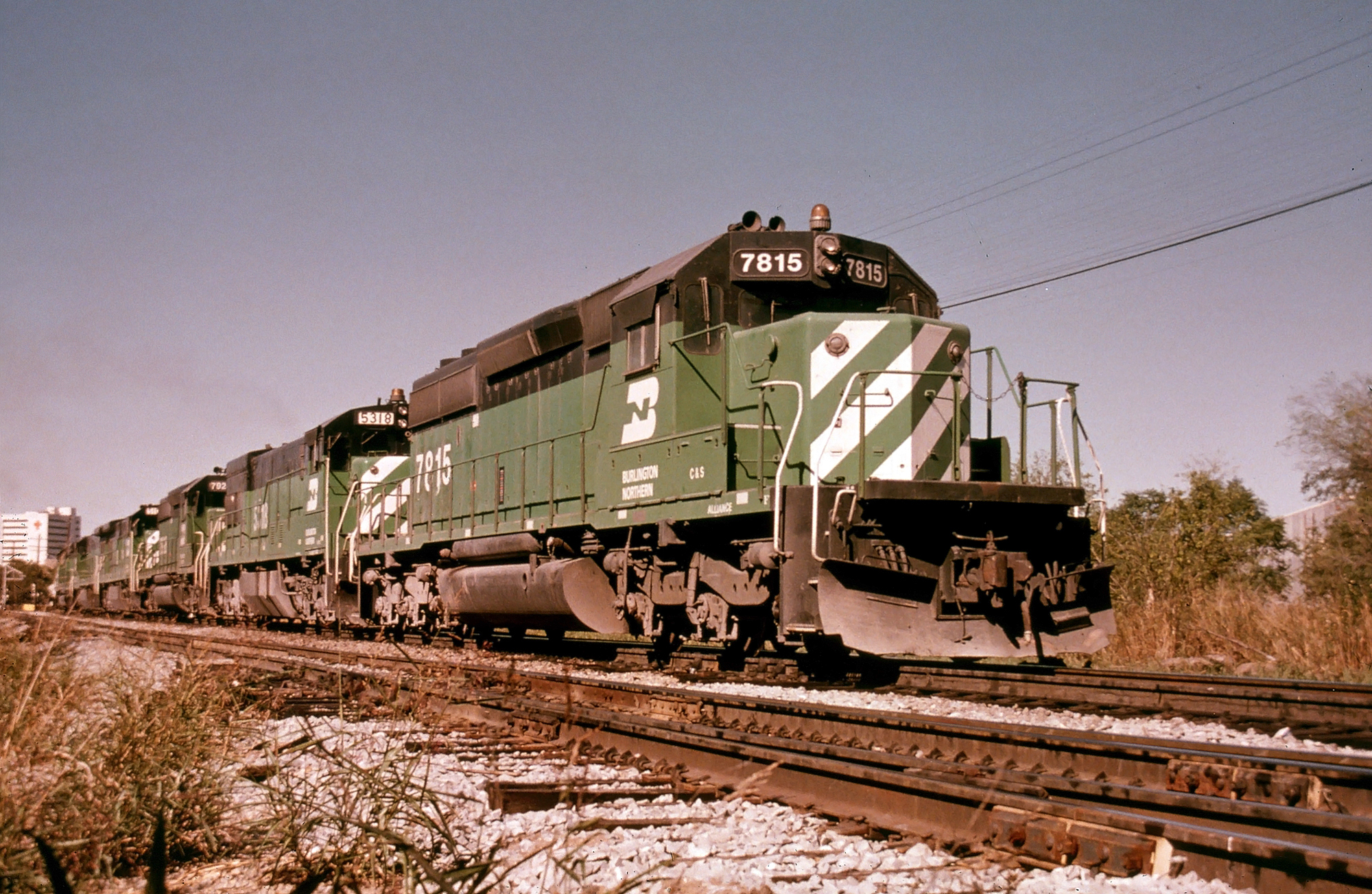 Burlington Northern power (led by Colorado & Southern SD40-2 #7815) at Temple, Texas, circa 1982. Mike Bledsoe photo. American-Rails.com collection.
Burlington Northern power (led by Colorado & Southern SD40-2 #7815) at Temple, Texas, circa 1982. Mike Bledsoe photo. American-Rails.com collection.As it turns out the merger's timing proved quite fortuitous. While the 1970's were a difficult decade for many, BN weathered these troubled times better than most. Not only did it bring together four strong carriers but the merger also occurred only a few years before two important pieces of legislation became law.
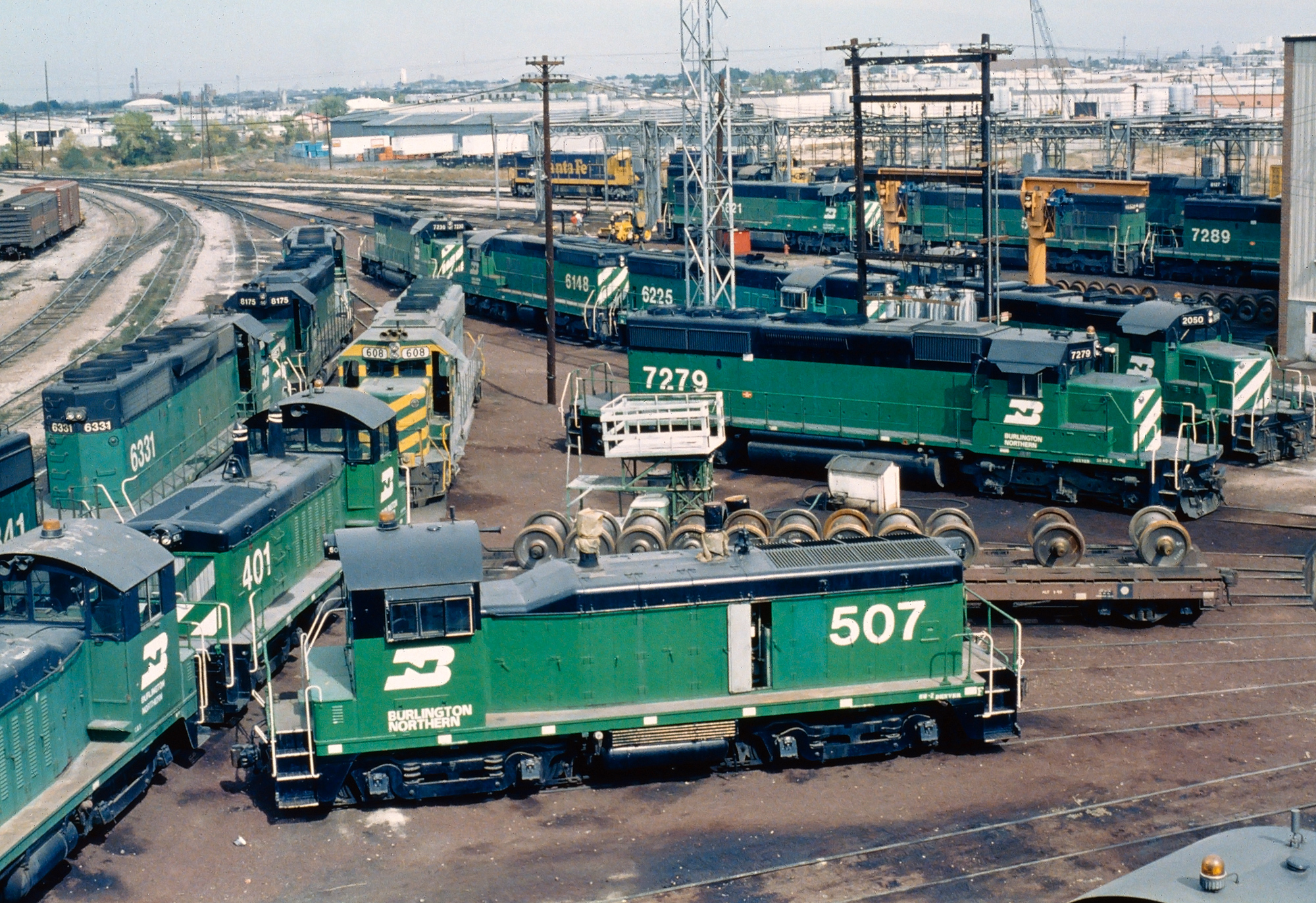 Lots of Burlington Northern motive power at rest at the railroad's engine facility in Denver, Colorado, circa 1983. Mike Bledsoe photo. American-Rails.com collection.
Lots of Burlington Northern motive power at rest at the railroad's engine facility in Denver, Colorado, circa 1983. Mike Bledsoe photo. American-Rails.com collection.The first took place in 1970 when Congress passed the Rail Passenger Service Act, later signed into law by President Richard Nixon. It created the National Railroad Passenger Corporation on October 30th that year; originally known as Railpax it was renamed Amtrak on April 17, 1971.
This new carrier took over most intercity passenger services and relieved many railroads from this money-losing burden. The second occurred only months later when the Clean Air Act was signed into law on December 31st.
At A Glance
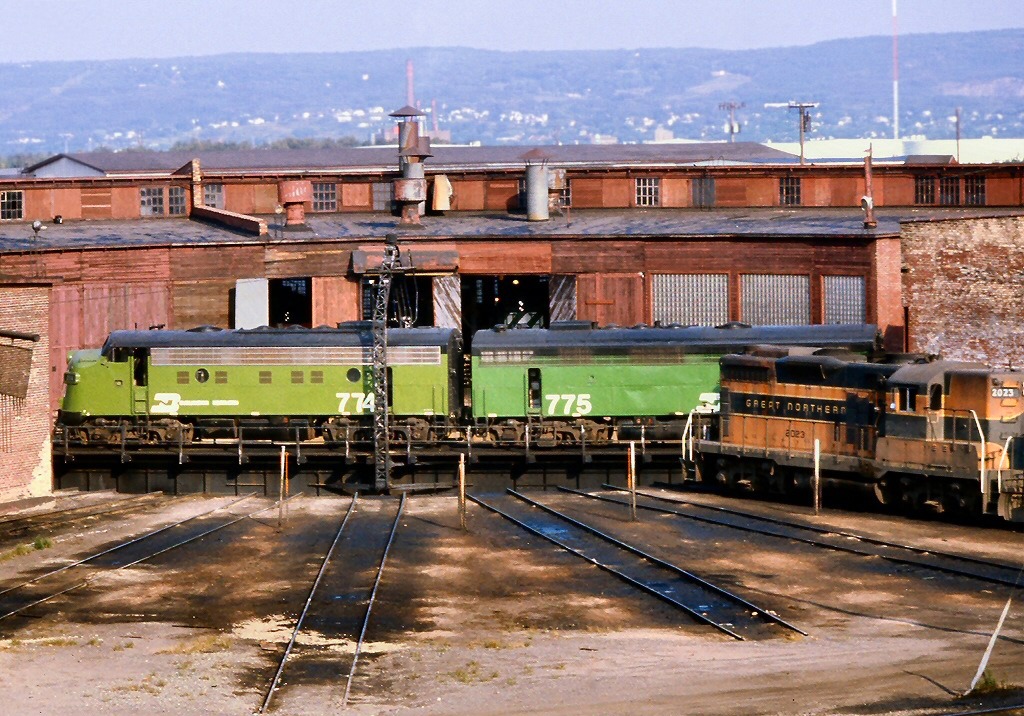 Burlington Northern F9A #774 and F9B #775 take a spin on the Belknap Street Roundhouse turntable in Superior, Wisconsin during August, 1976. Rob Kitchen photo.
Burlington Northern F9A #774 and F9B #775 take a spin on the Belknap Street Roundhouse turntable in Superior, Wisconsin during August, 1976. Rob Kitchen photo.According to the U.S. Environmental Protection Agency the act, in summary, addressed the following:
"The Clean Air Act is the comprehensive federal law that regulates air emissions from stationary and mobile sources. Among other things, this law authorizes EPA to establish National Ambient Air Quality Standards (NAAQS) to protect public health and public welfare and to regulate emissions of hazardous air pollutants.
One of the goals of the Act was to set and achieve NAAQS in every state by 1975 in order to address the public health and welfare risks posed by certain widespread air pollutants.
The setting of these pollutant standards was coupled with directing the states to develop state implementation plans (SIPs), applicable to appropriate industrial sources in the state, in order to achieve these standards.
The Act was amended in 1977 and 1990 primarily to set new goals (dates) for achieving attainment of NAAQS since many areas of the country had failed to meet the deadlines."
System Map (1988)
One of its most important goals was to reduce particulates released by coal-fired generating stations, which had traditionally used bituminous coal. This highly abundant resource is traditionally found east of the Mississippi River and, in particular, within the Southern Appalachian Mountains.
It was also relatively cheap to extract although its high levels of sulfur produced significant acid rain when burned. Powder River Basin coal, predominantly found in southern Montana and northeastern Wyoming, was also abundant but generated far less pollution.
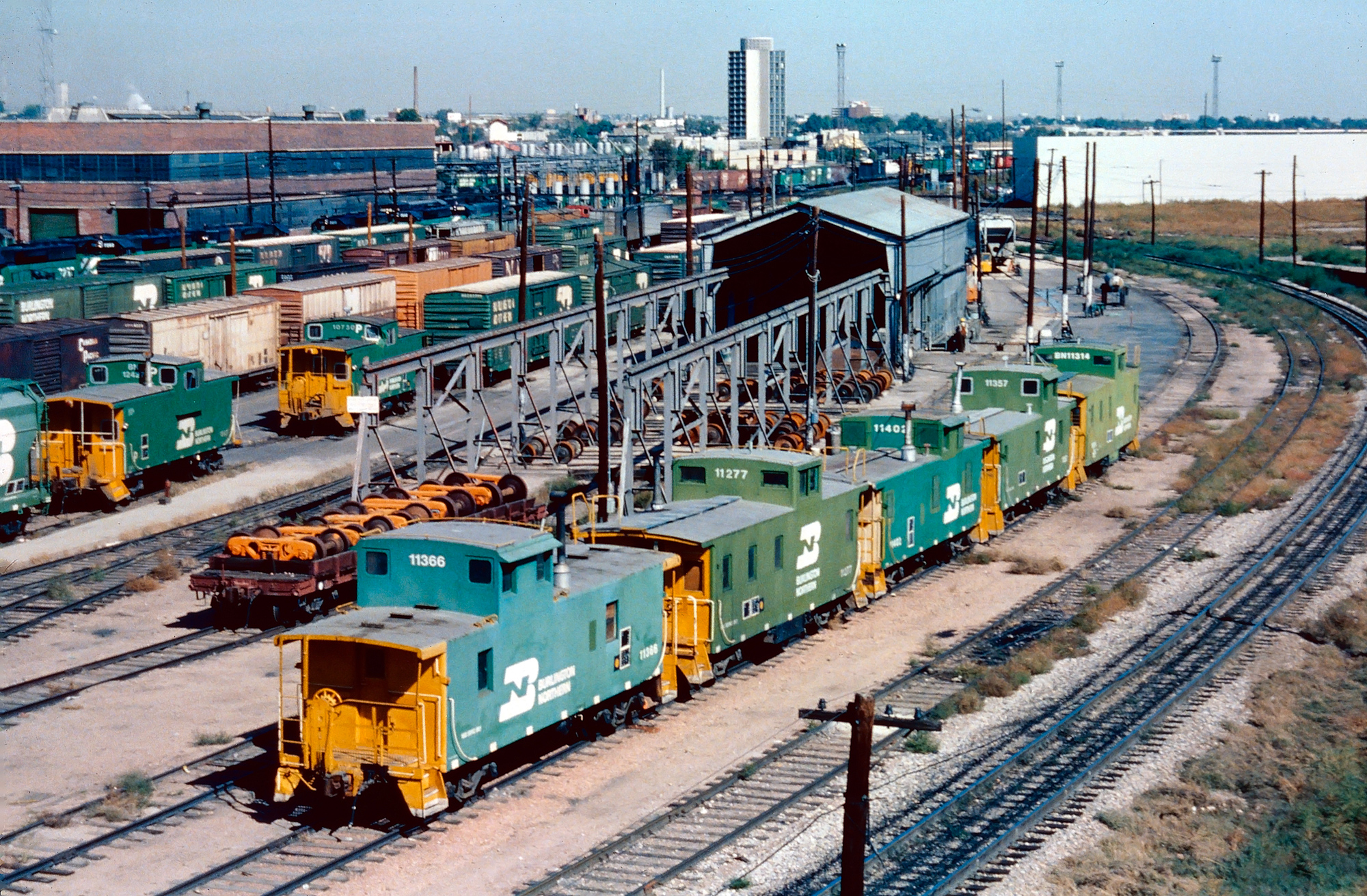 Burlington Northern's 31st Street Yard and engine facility in Denver, circa 1984. Mike Bledsoe photo. American-Rails.com collection.
Burlington Northern's 31st Street Yard and engine facility in Denver, circa 1984. Mike Bledsoe photo. American-Rails.com collection.It had never been mined in a great quantities until the 1970's. In his article, "The Empire Of BNSF: The Railroad That Would Be King" from the June, 2001 issue of Trains Magazine, historian Fred Frailey notes that BN garnered only $42 million from hauling coal during its first year (by comparison, Norfolk & Western at the time enjoyed four times the revenue from black diamonds).
This business was primarily handled from bituminous coal mines located in southern Illinois. That all changed with the Clean Air Act. In 1970, BN moved just 4 million tons of coal, a number which jumped to 7.2 million just two years later (ranking it behind only lumber and grain as the railroad's top commodity).
It then exploded to 31.4 tons in 1974. More than any other freight, coal was responsible for not only BN's renaissance but also its eventual rise into the nation's second most profitable railroad.
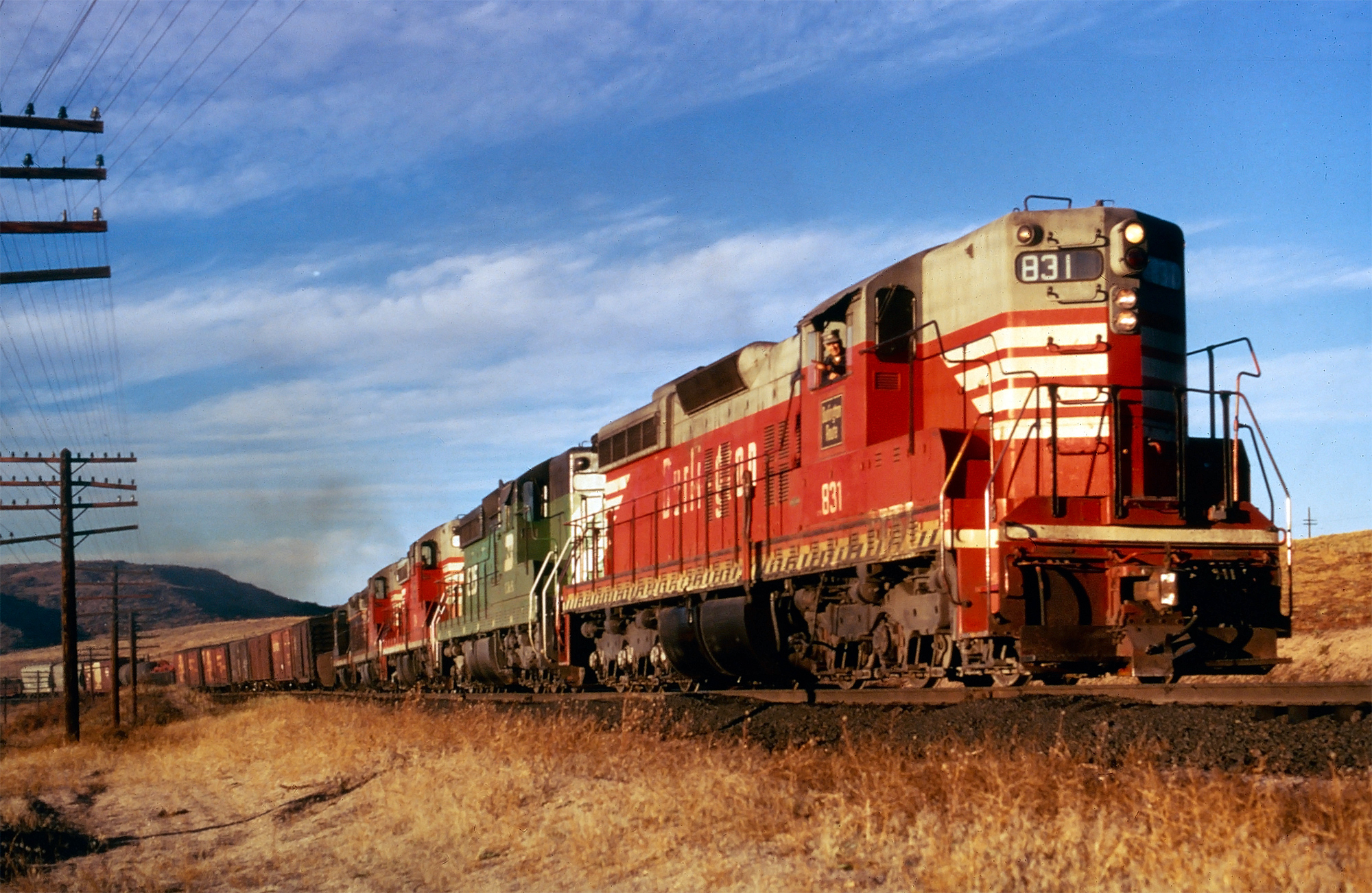 It's the very early Burlington Northern era as a group of Colorado & Southern SD9's, led by #831, work freight service south of Denver in the fall of 1970. American-Rails.com collection.
It's the very early Burlington Northern era as a group of Colorado & Southern SD9's, led by #831, work freight service south of Denver in the fall of 1970. American-Rails.com collection.All of BN's Powder River Basin (PRB) coal was handled over its Orin Subdivision, the former Burlington line running through northeastern Wyoming and southern Montana.
In 1977 the Black Thunder Mine opened here and quickly became the region's largest by volume (today it can produce near, or more than, 100 million tons annually). After struggling somewhat during its first few years (a result of high inflation, the oil embargo, and general economic downturn) it posted much stronger numbers as 1980 neared.
In 1970 it carried operating revenues of $800 million but by 1974 this had increased to $1.52 billion. The early 1980's brought three other major events which greatly improved BN's position; passage of the Staggers Act (1980), Milwaukee Road's abandonment of its western extension (1980), and merger with the St. Louis-San Francisco Railway (1981).
The Staggers Act (signed into law by President Jimmy Carter on October 14, 1980) was a boon for the industry as it made it far easier for railroads to reduce/abandon/sell excess capacity, carry out mergers, and enjoy greater freedoms in setting freight rates.
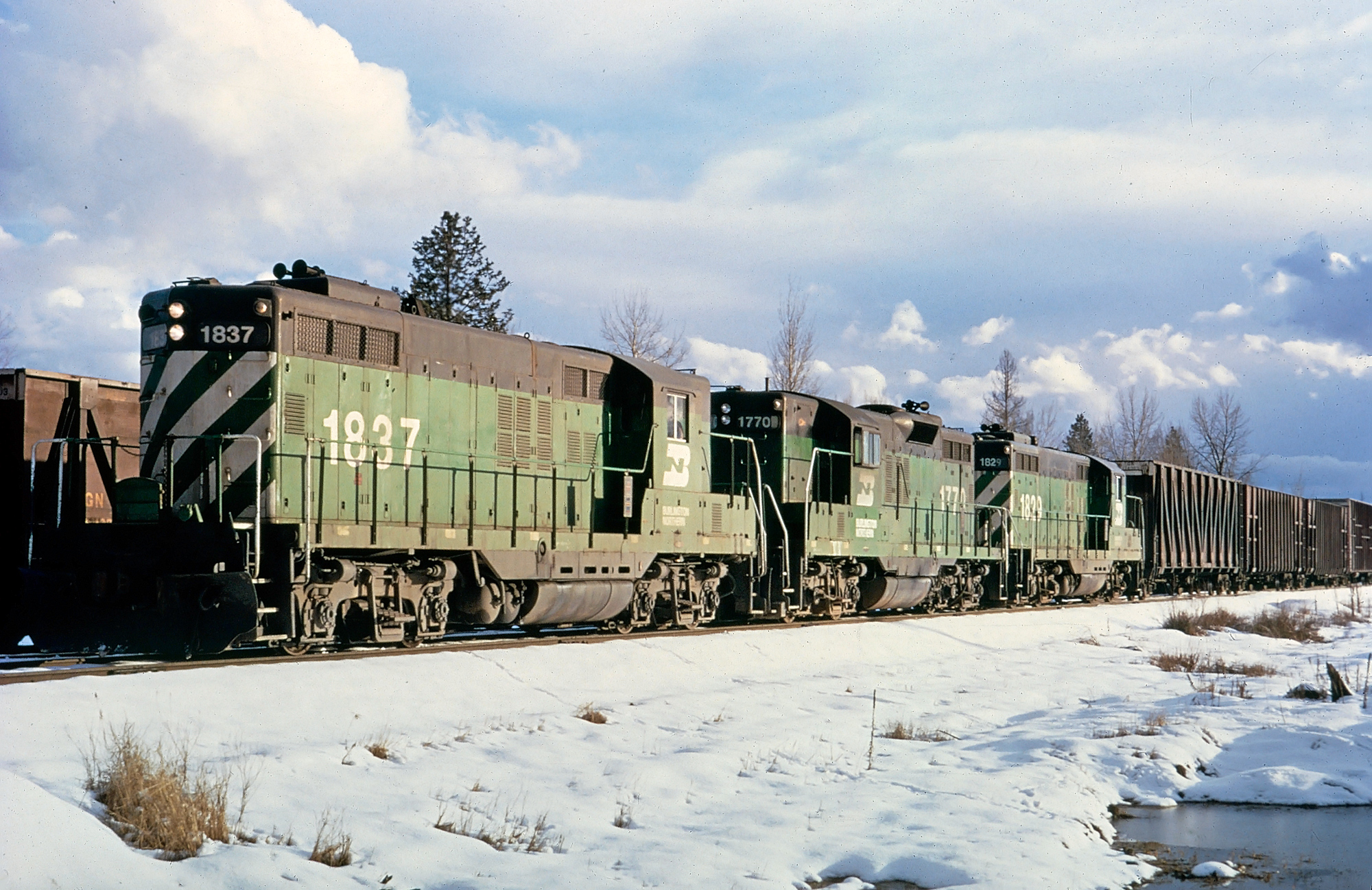 Burlington Northern GP9's #1837, #1770, and #1829 are seen here at work with woodchip cars, circa 1977. American-Rails.com collection.
Burlington Northern GP9's #1837, #1770, and #1829 are seen here at work with woodchip cars, circa 1977. American-Rails.com collection.BN was also awarded sole possession of the West in 1980 when the Milwaukee Road, having entered bankruptcy proceedings on December 19, 1977, elected to abandon its Pacific Extension west of Miles City, Montana.
The company's failure to challenge for transcontinental traffic was as much its own doing as any competition from BN.
Finally, the St. Louis-San Francisco Railway (Frisco) joined its network on June 8, 1981. It was a 5,000+ mile regional serving the states of Kansas, Missouri, Oklahoma, Texas, Arkansas, Alabama, Mississippi, and Memphis, Tennessee.
BN saw great value in the property thanks to Frisco's lucrative and growing petrochemical business along the Gulf Coast.
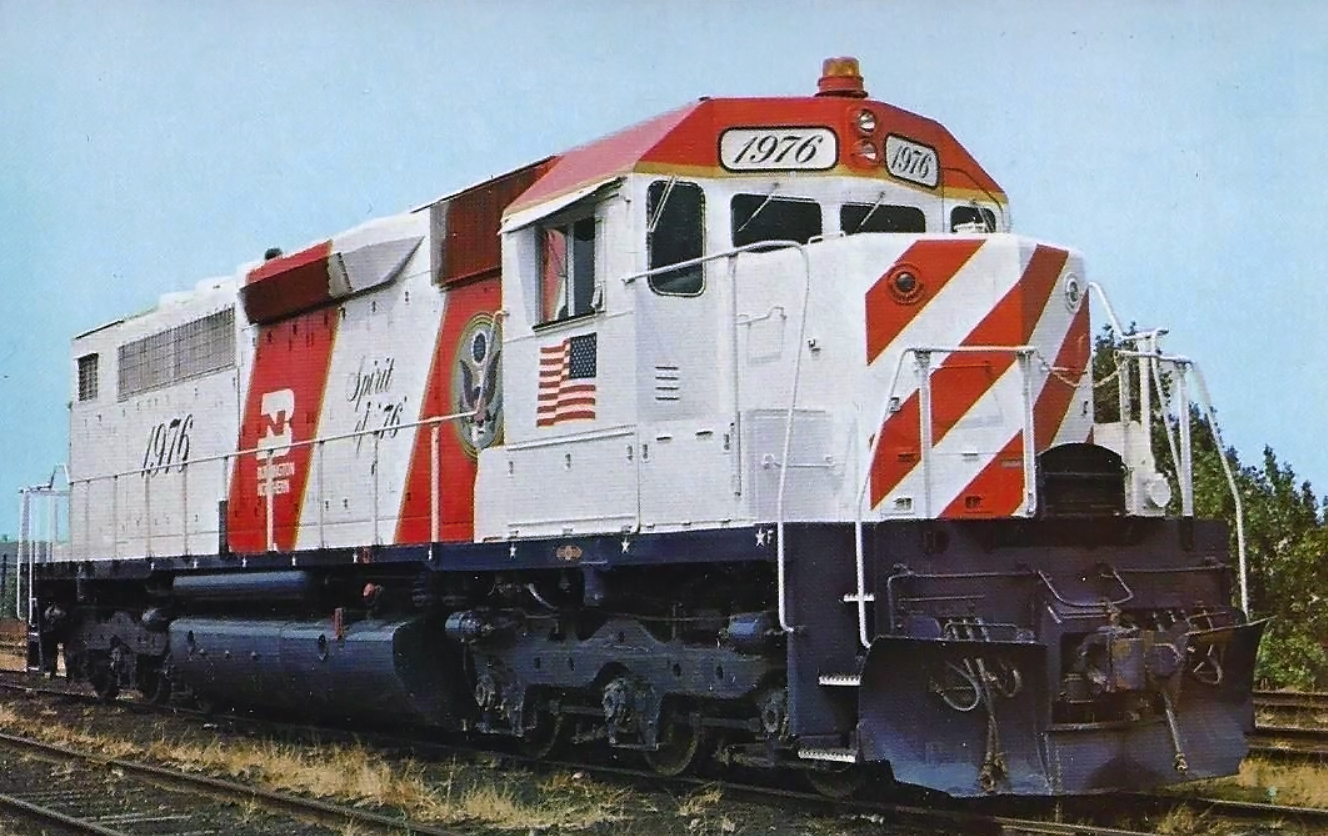 Burlington Northern SDP40 #6397, painted in the road's Bicentennial livery and given #1976, is seen here in Chicago during July of 1975. Ray Lackemeyer photo.
Burlington Northern SDP40 #6397, painted in the road's Bicentennial livery and given #1976, is seen here in Chicago during July of 1975. Ray Lackemeyer photo.As mergers continued throughout that decade the railroad continually focused on traffic growth. With the Staggers Act's passage, total traffic, nationally, had jumped 10% from 1980 to 1988, and 40% by 1995's merger with Santa Fe.
On July 20, 1983, BN implemented point-to-point scheduled intermodal service within dedicated unit trains between major markets, marking its start in this arena. During BN's last year of independence (1994), it enjoyed gross revenues of $4.995 billion.
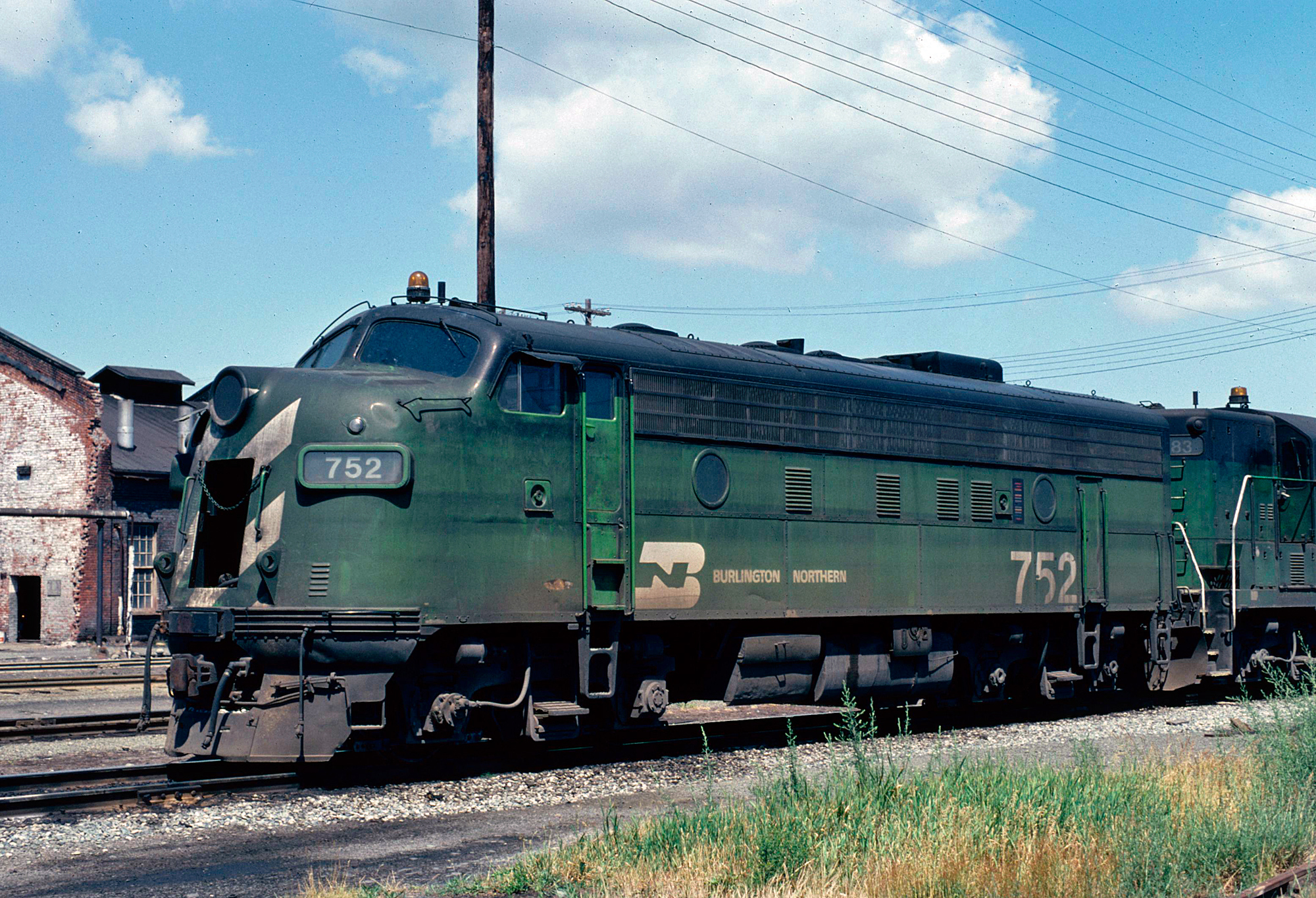 Burlington Northern F7A #752 (built as Northern Pacific #6019A) lays over in Auburn, Washington on June 7, 1979. Tim Dickinson photo. American-Rails.com collection.
Burlington Northern F7A #752 (built as Northern Pacific #6019A) lays over in Auburn, Washington on June 7, 1979. Tim Dickinson photo. American-Rails.com collection.Burlington Northern Santa Fe
When the last round of mergers took place and Union Pacific grew even larger by adding the Southern Pacific/Denver & Rio Grande Western and Chicago & North Western (largely for its Powder River Basin traffic) Burlington Northern knew it must find a partner.
After launching informal talks with the legendary Atchison, Topeka & Santa Fe the two carriers announced their merger intentions on June 30, 1994. The plan was approved by shareholders on February 7, 1995 and the Interstate Commerce Commission consented to the union on August 23, 1995.
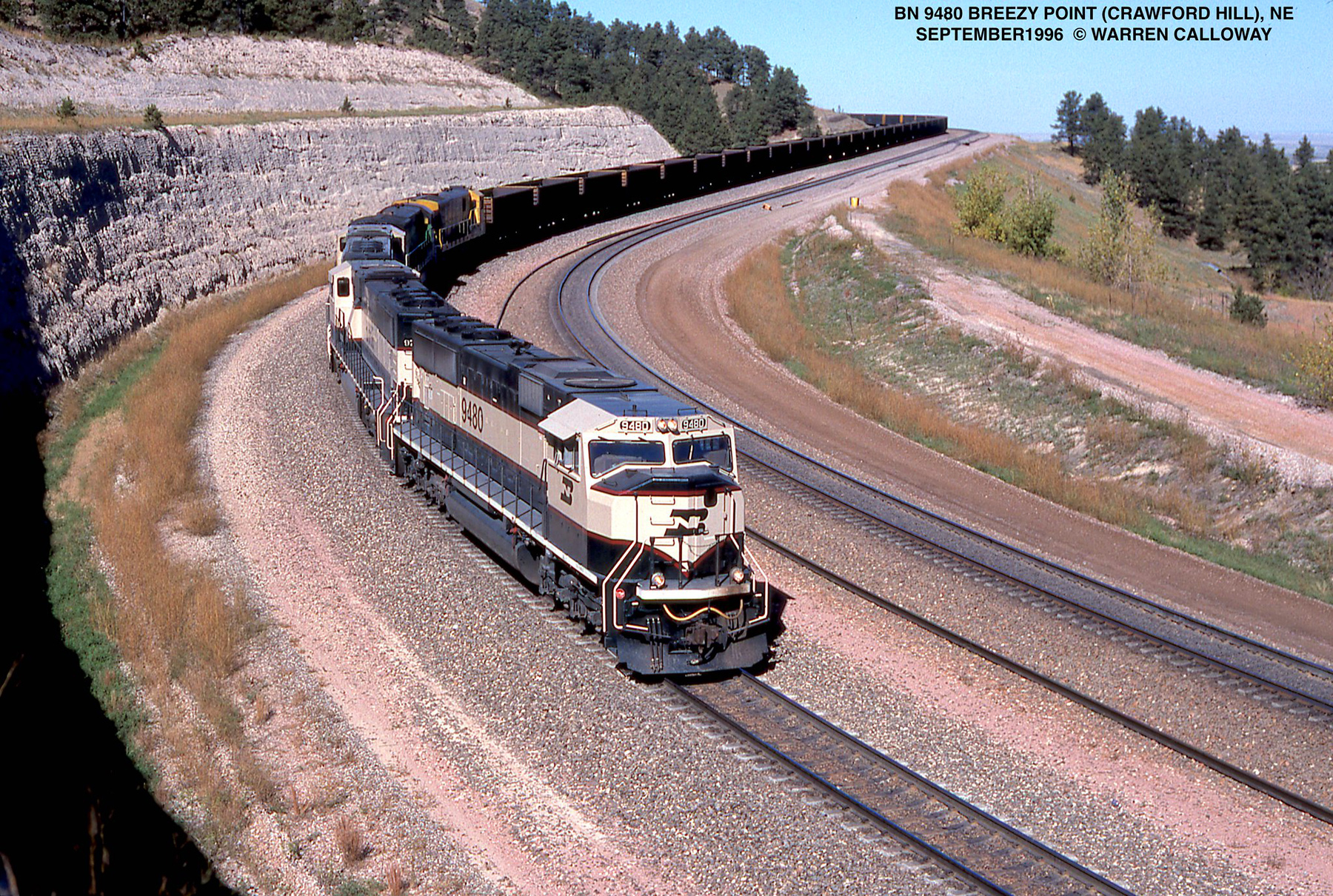 Burlington Northern SD70MAC's descend Crawford Hill in Nebraska with westbound empties in September, 1996. Warren Calloway photo.
Burlington Northern SD70MAC's descend Crawford Hill in Nebraska with westbound empties in September, 1996. Warren Calloway photo.From that point the process moved forward relatively quickly as the Burlington Northern Santa Fe Corporation was formed to acquire each railroad's holding company (Burlington Northern, Inc. and the Santa Fe Pacific Corporation), a process made official on September 22, 1995.
The last piece of the puzzle included merging the actual railroads; on December 31, 1996 Santa Fe and its iconic "Warbonnet" livery was dissolved into Burlington Northern, subsequently renamed as the Burlington Northern and Santa Fe Railway Company.
Today, what is known as BNSF Railway earns nearly the highest profits in the industry, has one of the lowest operating ratios, and derives a significant earnings from COFC (Container On Flat Car) shipments.
Photos
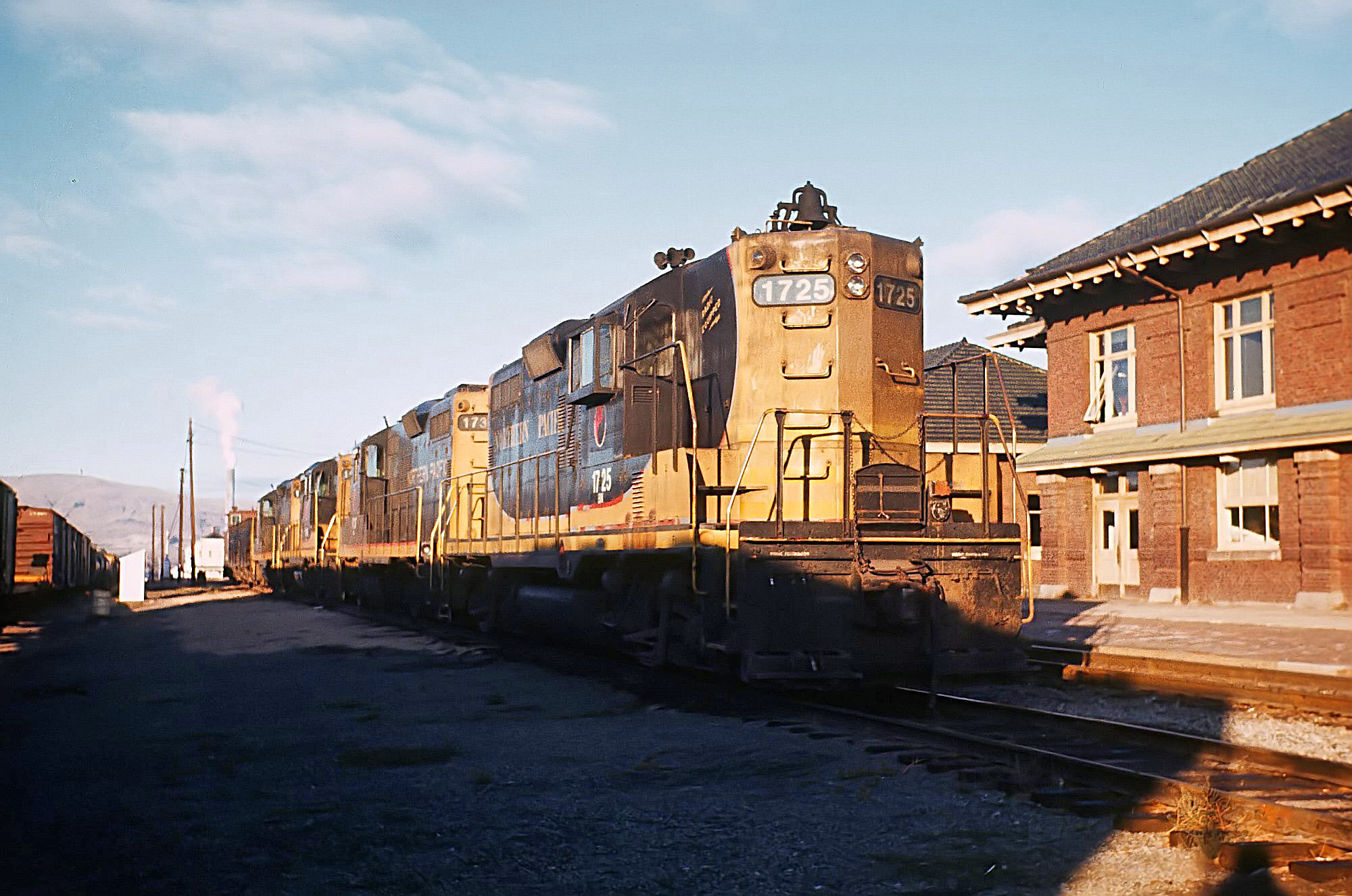 A group of former Northern Pacific GP9s, with #1725 closest to the photographer (ex-NP 287), are tied down at Butte, Montana during the early Burlington Northern era in September, 1970. Rick Burn photo.
A group of former Northern Pacific GP9s, with #1725 closest to the photographer (ex-NP 287), are tied down at Butte, Montana during the early Burlington Northern era in September, 1970. Rick Burn photo.Recent Articles
-
Arizona's - Wine Tasting - Train Rides
Jan 14, 26 02:04 PM
For those who want to experience the charm of Arizona's wine scene while embracing the romance of rail travel, wine tasting train rides offer a memorable journey through the state's picturesque landsc… -
Arkansas's - Wine Tasting - Train Rides
Jan 14, 26 01:57 PM
This article takes you through the experience of wine tasting train rides in Arkansas, highlighting their offerings, routes, and the delightful blend of history, scenery, and flavor that makes them so… -
Tennessee ~ Murder Mystery ~ Dinner Train Rides
Jan 14, 26 01:42 PM
Amidst the rolling hills and scenic landscapes of Tennessee, an exhilarating and interactive experience awaits those with a taste for mystery and intrigue. -
California ~ Murder Mystery ~ Dinner Train Rides
Jan 14, 26 01:26 PM
When it comes to experiencing the allure of crime-solving sprinkled with delicious dining, California's murder mystery dinner train rides have carved a niche for themselves among both locals and touri… -
Illinois ~ Murder Mystery ~ Dinner Train Rides
Jan 14, 26 01:13 PM
Among Illinois's scenic train rides, one of the most unique and captivating experiences is the murder mystery excursion. -
Vermont's - Murder Mystery - Dinner Train Rides
Jan 14, 26 12:57 PM
There are currently murder mystery dinner trains offered in Vermont but until recently the Champlain Valley Dinner Train offered such a trip! -
Massachusetts Dinner Train Rides On Cape Cod!
Jan 14, 26 12:20 PM
The Cape Cod Central Railroad (CCCR) has carved out a special niche by pairing classic New England scenery with old-school hospitality, including some of the best-known dining train experiences in the… -
Maine Dinner Train Rides In Portland!
Jan 14, 26 11:31 AM
While this isn’t generally a “dinner train” railroad in the traditional sense—no multi-course meal served en route—Maine Narrow Gauge does offer several popular ride experiences where food and drink a… -
Kentucky Dinner Train Rides In Bardstown!
Jan 13, 26 01:14 PM
The essence of My Old Kentucky Dinner Train is part restaurant, part scenic excursion, and part living piece of Kentucky rail history. -
Kansas Dinner Train Rides In Abilene!
Jan 13, 26 12:44 PM
If you’re looking for a heritage railroad that feels authentically Kansas—equal parts prairie scenery, small-town history, and hands-on railroading—the Abilene & Smoky Valley Railroad (A&SV) delivers. -
Michigan ~ Murder Mystery ~ Dinner Train Rides
Jan 13, 26 11:24 AM
Among the lesser-known treasures of this state are the intriguing murder mystery dinner train rides—a perfect blend of suspense, dining, and scenic exploration. -
Virginia's - Murder Mystery - Dinner Train Rides
Jan 13, 26 11:11 AM
Among the state's railroad attractions, murder mystery dinner trains stand out as a captivating fusion of theatrical entertainment, fine dining, and scenic travel. -
Arizona Dinner Train Rides At The Grand Canyon!
Jan 13, 26 10:59 AM
While the Grand Canyon Railway does not offer a true, onboard dinner train experience it does offer several upscale options and off-train dining. -
Georgia Dinner Train Rides In Nashville!
Jan 13, 26 10:27 AM
If you’ve ever wished you could slow down, trade traffic for jointed rail, and let a small-town landscape roll by your window while a hot meal is served at your table, the Azalea Sprinter delivers tha… -
Indiana Valentine's Train Rides
Jan 12, 26 04:27 PM
If you’ve ever wished you could step into a time when passenger trains were a Saturday-night treat and a whistle echoing across farm fields meant “adventure,” the Nickel Plate Express delivers that fe… -
Ohio Valentine's Train Rides!
Jan 12, 26 04:20 PM
The Hocking Valley Scenic Railway offers one of the region’s most atmospheric ways to experience the Hocking Hills area: from the rhythmic click of jointed rail to the glow of vintage coaches rolling… -
Wisconsin's - Wine Tasting - Train Rides
Jan 12, 26 03:10 PM
Wisconsin might not be the first state that comes to mind when one thinks of wine, but this scenic region is increasingly gaining recognition for its unique offerings in viticulture. -
California's - Wine Tasting - Train Rides
Jan 12, 26 02:34 PM
This article explores the charm, routes, and offerings of these unique wine tasting trains that traverse California’s picturesque landscapes. -
Wisconsin Scenic Train Rides In North Freedom!
Jan 12, 26 02:20 PM
The Mid-Continent Railway Museum is a living-history museum built around the sights, sounds, and everyday rhythms of small-town and shortline railroading in the early 20th century, what the museum cal… -
Vermont Scenic Train Rides In Burlington!
Jan 12, 26 01:18 PM
Today, GMRC is best known by many travelers for its Burlington-based passenger experiences—most famously the Champlain Valley Dinner Train and the sleek, limited-capacity Cocktails on the Rails. -
Maryland's - Murder Mystery - Dinner Train Rides
Jan 12, 26 01:03 PM
Maryland is known for its scenic landscapes, historical landmarks, and vibrant culture, but did you know that it’s also home to some of the most thrilling murder mystery dinner trains? -
Minnesota's - Murder Mystery - Dinner Train Rides
Jan 12, 26 12:17 PM
Murder mystery dinner trains offer an enticing blend of suspense, culinary delight, and perpetual motion, where passengers become both detectives and dining companions on an unforgettable journey. -
Vermont Dinner Train Rides In Burlington!
Jan 12, 26 12:09 PM
There is one location in Vermont hosting a dedicated dinner train experience at the Green Mountain Railroad. -
Connecticut Dinner Train Rides In Essex!
Jan 12, 26 10:39 AM
Connecticut's rail heritage can be traced back to the industry's earliest days and a few organizations preserve this rich history by offering train rides. The Essex Steam Train also hosts dinner-theme… -
Florida Scenic Train Rides In Parrish!
Jan 11, 26 10:26 PM
The Florida Railroad Museum (FRRM) in Parrish offers something increasingly rare in today’s rail landscape: a chance to ride historic equipment over a surviving fragment of an early-20th-century mainl… -
California's - Wine Tasting - Train Rides
Jan 11, 26 02:28 PM
This article explores the charm, routes, and offerings of these unique wine tasting trains that traverse California’s picturesque landscapes. -
Georgia's - Murder Mystery - Dinner Train Rides
Jan 11, 26 02:07 PM
In the heart of the Peach State, a unique form of entertainment combines the thrill of a murder mystery with the charm of a historic train ride. -
Colorado ~ Murder Mystery ~ Dinner Train Rides
Jan 11, 26 01:43 PM
Nestled among the breathtaking vistas and rugged terrains of Colorado lies a unique fusion of theater, gastronomy, and travel—a murder mystery dinner train ride. -
Minnesota Dinner Train Rides In Duluth!
Jan 11, 26 01:32 PM
One of the best ways to feel the region's history in motion today is aboard the North Shore Scenic Railroad (NSSR), which operates out of Duluth’s historic depot. -
Illinois Dinner Train Rides At Monticello!
Jan 11, 26 12:42 PM
The Monticello Railway Museum (MRM) is one of those places that quietly does a lot: it preserves a sizable collection, maintains its own operating railroad, and—most importantly for visitors—puts hist… -
Alabama's - Wine Tasting - Train Rides
Jan 10, 26 09:29 AM
While the state might not be the first to come to mind when one thinks of wine or train travel, the unique concept of wine tasting trains adds a refreshing twist to the Alabama tourism scene. -
Maryland Dinner Train Rides At WMSR!
Jan 10, 26 09:13 AM
The Western Maryland Scenic Railroad (WMSR) has become one of the Mid-Atlantic’s signature heritage operations—equal parts mountain railroad, living museum, and “special-occasion” night out. -
Arkansas Dinner Train Rides On The A&M!
Jan 10, 26 09:11 AM
If you want a railroad experience that feels equal parts “working short line” and “time machine,” the Arkansas & Missouri Railroad (A&M) delivers in a way few modern operations can. -
South Dakota's - Murder Mystery - Dinner Train Rides
Jan 10, 26 09:08 AM
While the state currently does not offer any murder mystery dinner train rides, the popular "1880 Train" at the Black Hills Central recently hosted these popular trips! -
Wisconsin's - Murder Mystery - Dinner Train Rides
Jan 10, 26 09:07 AM
Whether you're a fan of mystery novels or simply relish a night of theatrical entertainment, Wisconsin's murder mystery dinner trains promise an unforgettable adventure. -
Missouri's - Murder Mystery - Dinner Train Rides
Jan 10, 26 09:05 AM
Missouri, with its rich history and scenic landscapes, is home to one location hosting these unique excursion experiences. -
Washington ~ Murder Mystery ~ Dinner Train Rides
Jan 10, 26 09:04 AM
This article delves into what makes murder mystery dinner train rides in Washington State such a captivating experience. -
Kentucky Scenic Train Rides At KRM!
Jan 09, 26 11:13 PM
Located in the small town of New Haven the Kentucky Railway Museum offers a combination of historic equipment and popular excursions. -
Washington "Wine Tasting" Train Rides
Jan 09, 26 08:53 PM
Here’s a detailed look at where and how to ride, what to expect, and practical tips to make the most of wine tasting by rail in Washington. -
Kentucky's - Wine Tasting - Train Rides
Jan 09, 26 08:21 PM
Kentucky, often celebrated for its rolling pastures, thoroughbred horses, and bourbon legacy, has been cultivating another gem in its storied landscapes; enjoying wine by rail. -
Kentucky's - Murder Mystery - Dinner Train Rides
Jan 09, 26 01:12 PM
In the realm of unique travel experiences, Kentucky offers an enchanting twist that entices both locals and tourists alike: murder mystery dinner train rides. -
Utah's - Murder Mystery - Dinner Train Rides
Jan 09, 26 01:05 PM
This article highlights the murder mystery dinner trains currently avaliable in the state of Utah! -
North Carolina Dinner Train Rides At NCTM!
Jan 09, 26 12:51 PM
Tucked into the Piedmont town of Spencer, the North Carolina Transportation Museum is the kind of place that feels less like a typical museum and more like a living rail yard that never quite stopped… -
Tennessee Dinner Train Rides At The TVRM!
Jan 09, 26 12:39 PM
Tucked into East Chattanooga, the Tennessee Valley Railroad Museum (TVRM) is less a “museum you walk through” and more a railroad you step aboard. -
New York Scenic Train Rides On The A&A!
Jan 09, 26 11:20 AM
The A&A is both a common-carrier short line moving freight and a heritage railroad hosting popular excursion trains, all on the same storied right-of-way. -
Pennsylvania Scenic Train Rides In Hollidaysburg!
Jan 09, 26 11:14 AM
Tucked into the Juniata River valley just south of Altoona, the Everett Railroad offers one of the most approachable—and photogenic—heritage-rail experiences in Pennsylvania -
Montana Dinner Train Rides Near Lewistown!
Jan 08, 26 03:03 PM
The Charlie Russell Chew Choo turns an ordinary rail trip into an evening event: scenery, storytelling, live entertainment, and a hearty dinner served as the train rumbles across trestles and into a t… -
Alabama's - Murder Mystery - Dinner Train Rides
Jan 08, 26 02:19 PM
There is currently one location in the state offering a murder mystery dinner experience, the Wales West Light Railway! -
Rhode Island's - Murder Mystery - Dinner Train Rides
Jan 08, 26 01:43 PM
Let's dive into the enigmatic world of murder mystery dinner train rides in Rhode Island, where each journey promises excitement, laughter, and a challenge for your inner detective. -
Florida's - Wine Tasting - Train Rides
Jan 08, 26 01:13 PM
Wine by train not only showcases the beauty of Florida's lesser-known regions but also celebrate the growing importance of local wineries and vineyards.

